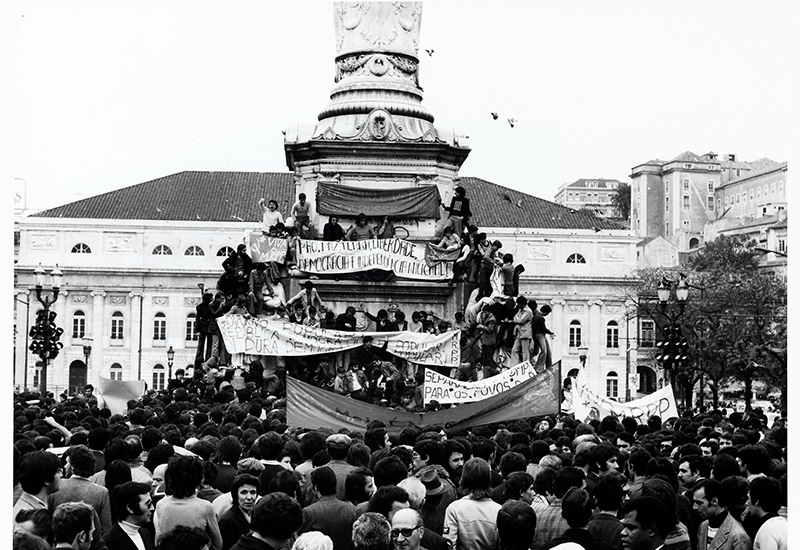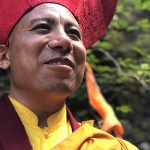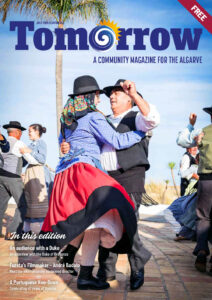This month we do well to remember the bloodless Carnation Revolution of 25 April 1974 that changed the course of Portugal’s history. One man that is indelibly linked to these events is Fernando José Salgueiro Maia.
He is still remembered today. Anyone who has visited the finance offices in Lagos may have seen a bronze bust nearby in the small square named after him. It would be surprising if there were a town or city in Portugal that doesn’t have a monument, a road, or a park called ‘Salgueiro Maia’. The revolution 49 years ago was by no means a one-person affair, but without Maia’s utter dedication, courage and fortitude, everything could have gone disastrously wrong.
Maia was born in 1944 in Castelo de Vide, near Portalegre, where he lived for the first few years. The only son of a railway worker, he lost his mother in a road accident when he was only four. After concluding his secondary education, Maia joined the Portuguese military in 1964. While a young captain stationed in Santarém, he became aware of the Armed Forces Movement (MFA), an underground movement of army captains opposing the oppressive government of the Estado Novo (New State), which had been in place since 1939, mainly under the dictator Salazar.
In 1966, Maia was sent on his first commission to fight in the colonial wars, which had started five years earlier. He soon realised the harsh reality of war and the futility of pursuing the overseas military campaign. His wife Natércia recalled: “When he went to Mozambique, there was that spirit of a knight, of saving the nation, and those ideas instilled by his training and by the Military Academy. But when he got there, he saw those ideals didn’t make sense.” On his return from Guinea in October 1973, he joined the coordinating committee of the MFA. Now the die was truly cast.
Maia was chosen to lead the military advance on Lisbon from dozens of eligible candidates. He was given the mission to command the column that, departing from Santarém, would join the other units in Lisbon. In addition, he was also in charge of preparing materials and vehicles for the operation.
Secret radio signals were broadcast to indicate the start of the revolution. The first one was the song E Depois do Adeus by Paulo de Carvalho (known for the Portuguese entry in the Eurovision Song Contest, 1974 in Brighton). It was to alert Maia and his cadets to act.
The other signal was Grândola, Vila Morena, a folk songby the great singer and composer Zeca Afonso. It indicated that the coup leaders had taken control of strategic parts of the country. This song has been played in every town in Portugal on 25 April since that day.
When the first signal was acknowledged, Maia addressed a gathering of men under his command in the barracks. These are the often-quoted words he used: “Gentlemen, as you all know, there are various forms of state. The socialist state, the capitalist state and the state we are in. Now, on this solemn night, we will end this state. So, anyone who wants to come with me will go to Lisbon, and we will finish it. If you volunteer, go outside, and form up. If you do not want to go, stay here.”
Maia had more than enough volunteers. The detachment consisting of 250 men, including ten armoured cars and personnel carriers, 12 troop transporters, two ambulances, and a command jeep, set off from Santarém at 3.03am and arrived in Terreiro do Paço, Lisbon, at 5.45 am.
Despite the ever-increasing tension, Maia remained calm. Soon after his arrival, he radioed the command post: “We have occupied Terreiro do Paço and are in control of the Bank of Portugal and Radio Marconi.”
But it was far from over. Forces from the GNR and troops loyal to the government were on their way. The frigate Gago Coutinho was ordered to fire on Maia’s column, but the ship’s gunners refused to obey orders. In the square, Maia advanced towards a line of government soldiers who had been given the order to shoot him. He stood unfazed with his arms outstretched and a white handkerchief in his hand. The officers and sergeants of the government troops, many of whom were former colleagues of Maia, went over to the side of the revolutionaries.
He also carried a live grenade in his pocket, prepared to sacrifice himself. His rationale was that the revolution would have succeeded if they didn’t shoot him. If he was blown up, he would become a martyr and the revolution would be won anyway.
At 11 am, Maia was ordered by commander Otelo Saraiva, the chief strategist in Lisbon, to take his troops to Largo do Carmo to surround the National Guard barracks. This safehold was where the head of government Marcelo Caetano and some ministers had taken refuge. (After Salazar died in 1970, Caetano succeeded him.)
The tensest moments in the history of the operation followed. Government tanks were advancing, and a helicopter could be heard above, but Maia kept his cool. Then, standing on an armoured carrier with a megaphone, he issued an ultimatum of surrender. No response.
Hours passed, and still no sign from inside. Finally, at around 5 pm, Maia decided to enter the barracks and managed to speak to Caetano. Facing the inevitable, Caetano accepted the terms of surrender but would only cede power to a superior officer, General António de Spinola. The general, later to become President of the Republic, was given command of the provisional government in preparations for free elections. Maia escorted Caetano safely to the airport, where a plane took the former dictator to Brazil, where he spent the rest of his life.

The dictatorship of more than four decades had ended without bloodshed, and a new era had begun.
Why was it called the Carnation Revolution? Despite repeated radio appeals by the MFA to stay indoors, the streets were flooded with thousands supporting the insurgents. As one of the gathering points was by the Lisbon flower market, soldiers were given red carnations. The image of the red carnations in the barrels of the guns became iconic and gave the revolution its name.
And what became of Salgueiro Maia? As opposed to many of his comrades, he never wanted to pursue a political career afterwards. He wasn’t a consensus figure, as he wouldn’t align himself with factions on the left or right. All he wanted was to pursue his army career, and he was subsequently promoted to Major and later Lieutenant Colonel.
The government of the conservative Cavaco Silva denied him a pension for extraordinary services to the country in 1988. However, it saw fit to grant pensions to several ex-members of PIDE, the repressive police of the dictatorship. The following year Maia was diagnosed with cancer and, after surgeries and a long, painful process, he died on 4 April 1992 at the age of only 48.
Ever modest and self-effacing, he left a handwritten note declaring: “I wish to be buried in Castelo de Vide, in a shallow grave; and use the cheapest coffin on the market. Its transport must be done by the most economical means, preferably in a military vehicle. During the funeral, only the presence of friends, I ask to sing Grândola Vila Morena and Marcha do MFA.”
Although a military man to the end, Maia had wider interests. He gained a university degree in Social and Political Sciences along with Anthropology. The mayor of the first elected City Council of Santarém, Luís Eugênio Martins, remembers Maia fondly: “He was a very cultured individual, with an interest in history. We discussed philosophy a lot.”
It was only after his death that he received official acknowledgement. President Marcelo Rebelo de Sousa awarded him posthumously the Grand Cross of the Order of Infante D. Henrique on 25 April 2016. The decoration was handed to his widow, Natércia, on 30 June 2016, the day that would have been her husband’s 72nd birthday.
Additionally, two years ago, a museum – Casa da Cidadania Salgueiro Maia (Salgueiro Maia Community House) – in Castelo de Vide was inaugurated, celebrating the life and achievements of Maia, with the presence of the President of the Republic.
In April 2022, the film Salgueiro Maia – O Implicado (The Implicated), directed by Sergio Graciano, was released. “The homage is slightly late,” Graciano admitted shortly before the premiere in Lisbon. The film is presented as “the story of a true Portuguese hero. For himself, he asked nothing, for the country all.” Perhaps this accolade sums up Salgueiro Maia perfectly.
We are bound to hear the tunes of Grândola, Vila Morena up and down the country on the 25 April this year too. So, let’s spare a thought for men like Salgueiro Maia, who gave their all for a cause they believed in.
On 25 April there will be a photo exhibition at the Portimão Museum entitled E Depois do Adeus.
Distinguished photojournalist Marques Valetim presents 50 photos from the last 50 years of Portugal’s history.
Main image: Salgueiro Maia is photographed by his wife during a parade, in Santarém Natércia Maia, CC0, via Wikimedia Commons













